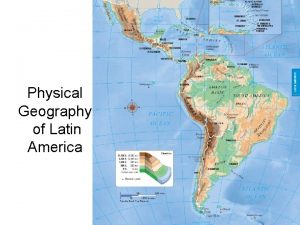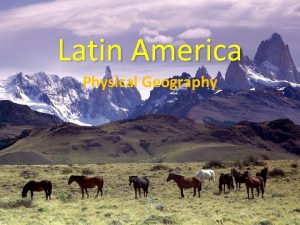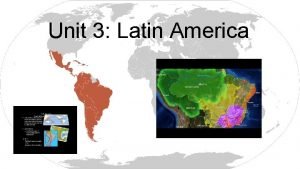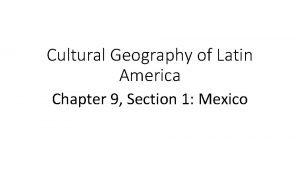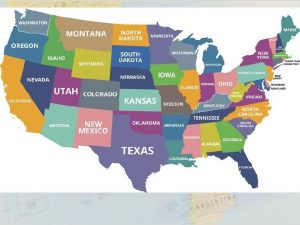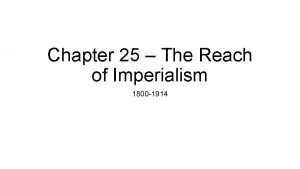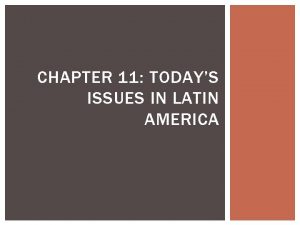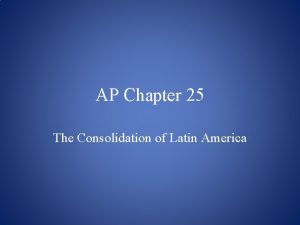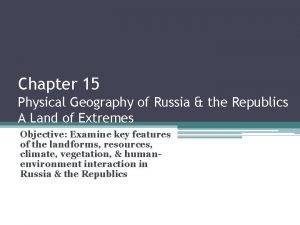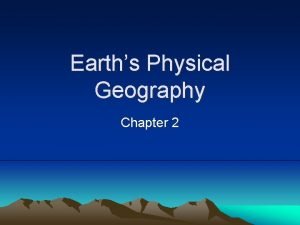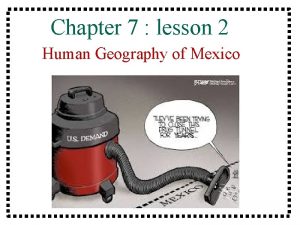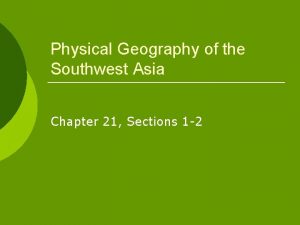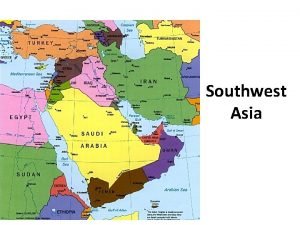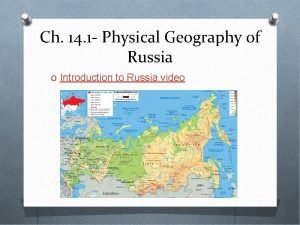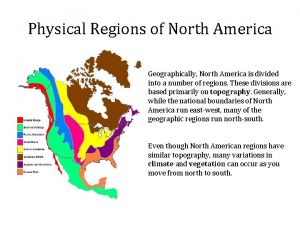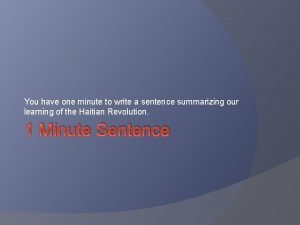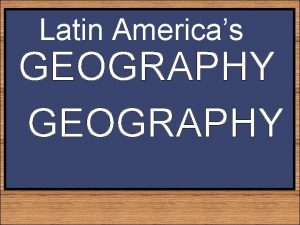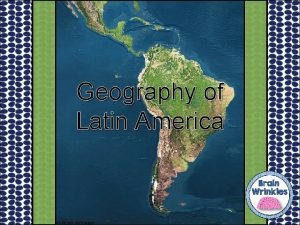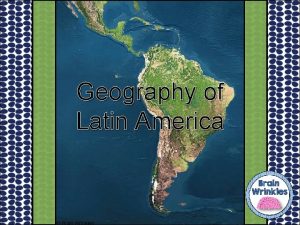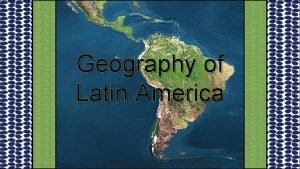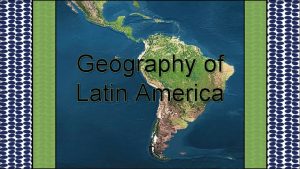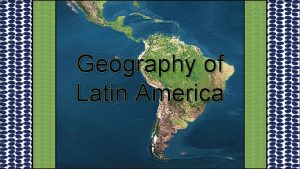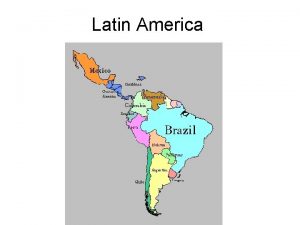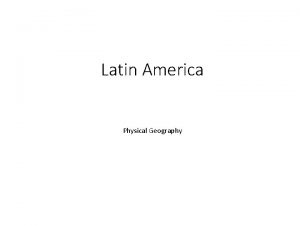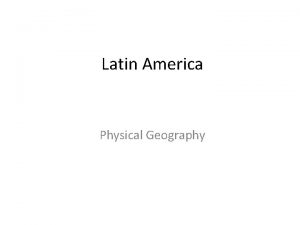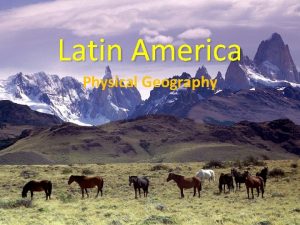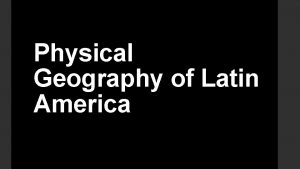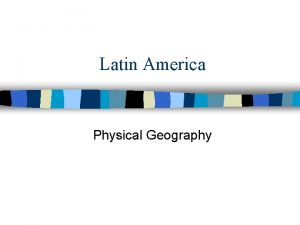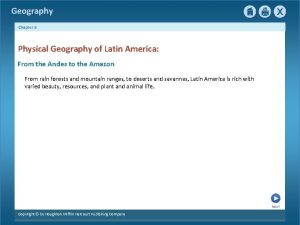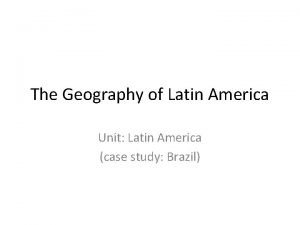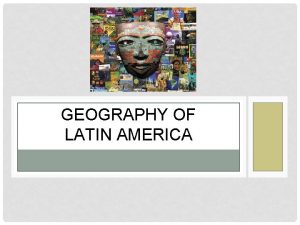Latin America Chapter 9 Physical Geography Latin American







































- Slides: 39

Latin America Chapter 9 Physical Geography

Latin American Regions • Middle America – includes Mexico and the Central American countries • The Caribbean Islands • South America

Landforms • Mexico – Sierra Madre Oriental & Occidental Mountains – Anáhuac – densely populated plateau Oaxaca Plateau, Mexico

Sierra Madre Ranges

Andes Mountains • Longest mountain range in the world • Stretches 4, 500 miles from north to south, along the west coast of South America • Highest peak, Aconcagua, rises 23, 000 feet Aconcagua

Landforms PLAINS • Llanos - vast tropical grassland plain situated at the east of the Andes in Colombia & Venezuela (cattle ranching) • Pampas - fertile plains in Argentina, Uruguay, & Brazil (grain, cattle, & sheep) PLATEAUS • Patagonia – cold, windswept plateau in Argentina & Chile • Altiplano – high plateau in Chile, Argentina, Bolivia & Peru

Atacama Desert • Located in Chile and Peru • Driest desert on Earth • Rich deposits of copper and other minerals

Amazon Rainforest South America • Covers 1. 2 billion acres • More than 1/5 of the rainforest has already been destroyed • One square kilometer of the Amazon rainforest can contain about 90, 000 tons of living plants.

Amazon Rainforest • The region is home to 2. 5 million insect species, tens of thousands of plants, and some 2, 000 birds and mammals. Tapir Orchid

Amazon River • Longest River in the Western Hemisphere • Greatest total water flow of any river, carrying more than the Mississippi, Nile, and Yangtze rivers combined • Drainage area, called the Amazon Basin, is the largest of any river system Amazon River near Manaus

Amazon River

Amazon River

Amazon River

Paraná, Paraguay, & Uruguay River System • 2 nd longest river system in South America • Most important commercial highway Rio Parana from Encarnacion, Paraguay, looking to Posadas, Argentina

Orinoco River • Mainly in Venezuela • More that 1, 500 miles long into the Atlantic • Some of the areas drained by the Orinoco are home to the few remaining Native American peoples, such as the Yanomamo

Amazon River Dolphin • Found in the Amazon and Orinoco Rivers • 1 of 5 freshwater dolphin species in the world • Unique pink coloring • Also known as “Boto”

Lake Titicaca • Highest commercially navigable lake in the world (12, 536 ft. above sea level) • South America’s largest freshwater lake • Located in the Altiplano high in the Andes on the border of Peru and Bolivia

Lake Maracaibo • Located in Venezuela • Contains large reserves of crude oil • Connected to the Gulf of Venezuela by a narrow strait in the north, making it slightly saline

Lake Nicaragua • Largest lake in Central America • Located in Nicaragua • Called “The Sweet Sea” • Has sizeable waves and archipelagos of islands • Lake Nicaragua has the only species of freshwater sharks in the whole world.

Angel Falls • World’s highest uninterrupted waterfall at 3, 230 feet • Located in Venezuela • The waterfall was not known to the world until its official discovery in 1933 by the American aviator, James Crawford Angel, on a flight while searching for gold. • 16 times the height of Niagara Falls

Angel Falls

Major Islands • Greater Antilles – Large islands in the Caribbean – Cuba, Jamaica, Hispaniola (Haiti & Dominican Republic), Puerto Rico • Lesser Antilles – Smaller islands in the region SE of Puerto Rico – Divided into the Windward (winds that blow across them) and Leeward (sheltered) Islands

Greater Antilles

Lesser Antilles

Mineral Resources • Bauxite (used to make aluminum) • Copper • Tin • Iron • Lead • Nickel • Silver • Gold Bauxite

Energy Resources • • • Oil – Venezuela & Mexico Coal Natural gas - Trinidad Uranium Hydroelectric power - Brazil

Hydroelectric power plant in Brazil

Varied Climate & Vegetation • Varied climate and vegetation due to several factors: – Spans a great distance on each side of the equator – Big changes in elevation because of massive mountains – Warms currents of the Atlantic Ocean & the cold currents of the Pacific Ocean affect the climate

Tropical Climate Zones • Tropical Wet – Rain forests – Hot and rainy year round – Most of Brazil • Tropical Wet & Dry – Savannas – Hot climates with seasonal rains – Found of Brazil, Colombia, & Argentina


Dry Climate Zones • Desert – Less than 10 inches of precipitation a year – Northern Mexico, coast of Peru, Atacama Desert in Chile, part of Patagonia • Semiarid – Generally dry, with some rain – Parts of Mexico, Brazil, Uruguay, & Argentina

Mid-Latitude Climate Zones • Humid Subtropical – Rainy winters and hot, humid summers – Varied vegetation – Parts of Paraguay, Uruguay, southern Brazil, southern Bolivia, and northern Argentina • Mediterranean – Hot, dry summers and cool, moist winters – Chapparal vegetation – Located in part of Chile • Marine West Coast – Cool, rainy winters and mild, rainy summers – Forests – Southern Chile & Argentina • Highlands – Moderate to cold, depending on elevation – Mountains of Mexico & South America

Human/Environment Interaction • • Slash-and-Burn farming Terraced farming Urbanization Tourism

Slash-and-Burn Farming - Used by native peoples to clear fields - Cut trees, brush, grasses and burned the debris to clear the field • Today, farmers practice this method to clear land for farming in the Amazon River basin • Sometimes use destructive farming practices • Soil is exhausted after a few years and all nutrients have been drained from the soil • Then they move on and clear another spot • This is one of the reasons for the shrinking of the rainforest

Before & After

The aftermath of slash and burn farming in the Amazon.

Terraced Farming • Ancient technique for growing crops on hillsides or mountain slopes • Cut step-like horizontal fields into hillsides and slopes • Allow steep land to be cultivated for crops • Reduces soil erosion


Tourism • Advantages of Tourism – Create jobs • Disadvantages of Tourism – – Congestion Pollution Income gap between tourists and local residents Public debt due to borrowing money to build tourist facilities – Often, the owners of the hotels and airlines do not live in the country and the profits go elsewhere
 Chapter 8: the physical geography of latin america answers
Chapter 8: the physical geography of latin america answers Why is latin america called latin america
Why is latin america called latin america Physical geography of latin america worksheet answers
Physical geography of latin america worksheet answers What is another arm of the atlantic ocean cradled by mexico
What is another arm of the atlantic ocean cradled by mexico Unit 3 latin america
Unit 3 latin america Vocabulary activity 9 cultural geography of latin america
Vocabulary activity 9 cultural geography of latin america South america webquest
South america webquest Lesson 1 physical geography of south america
Lesson 1 physical geography of south america Voluntary trade cloze notes 1
Voluntary trade cloze notes 1 Latin america's geography cloze notes 1
Latin america's geography cloze notes 1 Latin america physical features
Latin america physical features Physical features of brazil map
Physical features of brazil map Where is latin
Where is latin Latin america physical map baja california
Latin america physical map baja california Chapter 25 lesson 2 empire building in africa
Chapter 25 lesson 2 empire building in africa Chapter 11 today's issues in latin america
Chapter 11 today's issues in latin america Chapter 25 the consolidation of latin america
Chapter 25 the consolidation of latin america Chapter 27 section 1 landforms and resources
Chapter 27 section 1 landforms and resources Chapter 15 physical geography of russia and the republics
Chapter 15 physical geography of russia and the republics Lesson 1 physical geography of southeast asia
Lesson 1 physical geography of southeast asia The barren rocky topography
The barren rocky topography Earth's physical geography chapter 2
Earth's physical geography chapter 2 Chapter 7 lesson 2 social studies
Chapter 7 lesson 2 social studies States west of the mississippi river
States west of the mississippi river Chapter 21 physical geography of southwest asia
Chapter 21 physical geography of southwest asia Chapter 21 physical geography of southwest asia
Chapter 21 physical geography of southwest asia Reteaching activity 14 physical geography of russia
Reteaching activity 14 physical geography of russia Rap of the states
Rap of the states America asia africa
America asia africa Repetition in let america be america again
Repetition in let america be america again Eu amo a américa e a américa me ama
Eu amo a américa e a américa me ama Chapter 8 section 1 latin american peoples win independence
Chapter 8 section 1 latin american peoples win independence South america facts geography
South america facts geography First people in the world
First people in the world Physical regions of north america
Physical regions of north america Frq examples ap human geography
Frq examples ap human geography 5 themes of geography ap human geography
5 themes of geography ap human geography Proruption ap human geography
Proruption ap human geography Penisulares
Penisulares Economic imperialism in latin america
Economic imperialism in latin america


